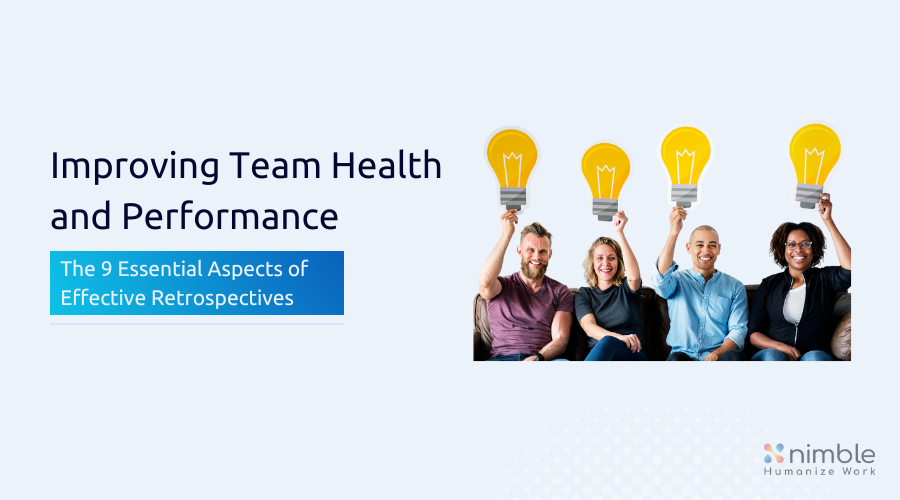Navigate to
Team Health and Retrospectives: 9 Essential Aspects
- 7 mins read
- By Lindsey Stefanka

Retrospectives are a great way to improve.
Many teams use them to solve technical issues.
But if you limit yourself to that, you miss a significant performance element: team health.
Team health directly influences how your team interacts and collaborates, making or breaking the success of your projects.
So, what is team health, and how can you use retrospectives to improve it?
Let’s dive in to find out.
What Are Retrospectives?
Retrospectives are meetings where you come together as a team to reflect on past events.
The goal is to identify what went well, what didn’t, and to figure out how to sustain the first and improve the latter.
Retrospectives are well known in agile software development, but you can use them to your advantage in any environment where people work together toward a common goal.
The Benefits of Health-Focused Retrospectives
A great team is more than a collection of people working on the same thing and following orders.
For a group to grow into a high-performing team, all members need a deep sense of purpose, interdependence, and mutual accountability to achieve their goals.
You’ll have to prioritize team health to meet those needs.
Team health retrospectives are a good way to do that. They’ll help you steadily improve by using the right exercises and solutions.
Benefits of team health retrospectives include:
• Providing teams with a healthy outlet: Transparency and open dialogue are crucial ingredients for a well-functioning team. When everyone works to foster psychological safety, they feel comfortable sharing ideas, recommending changes, and working together toward a solution.
• Building trust within the team: Communication fosters trust and engagement. When everyone is heard and comfortable contributing, teams can build the trust necessary to solve problems and make the best decisions for the task at hand.
• Supporting problem-solving and responsiveness to changes: Change is inevitable. In fact, change is a sign of engagement. And when teams have a say in a task, they’re much more likely to offer solutions to problems and work toward the best outcome.
• Having more fun at work together than individually: The last thing you want is for your retrospectives to be boring! It hinders morale and engagement. But when you focus on team health and ensure everyone feels comfortable, included, and engaged, you’ll find that it’s a lot more fun than ignoring the problem.
Each of these effects alone contributes to your team’s success. Together, they paint an even clearer picture: success happens when team health is supported.
9 Essential Aspects for Team Health Retros
1. Face-to-Face Communication
With today’s remote landscape, your first instinct may be to conduct team health checks with a digital survey and leave it at that.
Sounds easy enough, doesn’t it?
But without discussing the findings, you miss out on the conversation — and that’s the biggest part of the value (not to mention surveys aren’t always a magnet for fun).
Face-to-face communication establishes trust and engagement, crucial for earnest communication and morale.
The solution?
Merge the best of both worlds.
Host either in-person or face-to-face remote retrospectives and use digital tools, like Nimble Retro, to survey team health, structure the conversation, and improve psychological safety through anonymity.
That’ll get you much better results.
2. Knowledge-Sharing
Teams whose members freely share their knowledge, ideas, and information relevant to their work, enjoy higher team morale and creativity.
It may sound obvious, but it’s often missed.
Encourage knowledge sharing by helping everyone to feel confident in their skills and safe in their team. Inclusion safety and open dialogue play a vital role in this.
3. Inclusion Safety
Team members who feel psychologically safe engage, collaborate, and contribute to organizational innovation.
You already know that engagement and collaboration are key to a healthy team dynamic.
And real innovation only happens in a healthy team where everyone feels safe.
Inclusion safety, specifically, is key to the most basic human need: to feel connected to others. When you feel safe to be yourself and are accepted for who you are, you’re more likely to share your unique attributes and defining characteristics.
This can mean literally included, by drawing awareness to any unconscious biases in your organization and educating your team on the importance of equity, diversity, and inclusion initiatives, as well as feeling mentally included.
4. Open Dialogue
Fostering an open dialogue approach allows team members to share their ideas and concerns, making them feel comfortable and valued.
Retrospective facilitators can support this open approach by asking powerful, open-ended questions. For example, “How could we make team health checks more enjoyable?”
It’s important not to control the conversation, but to facilitate it by getting the ball rolling.
And, of course, let team members adjust the questions as needed to get to the core of what’s going on in the team and have a stake in the decisions being made.
5. Team Involvement
When teams have a say in a task at hand, they’re much more likely to be invested in it. And having a greater stake in a task or project can increase the engagement and satisfaction of seeing it through to the end.
Long story short, let teams modify the retrospective model as they see fit.
This level of involvement will ensure they believe in what they’re working toward and the opportunities it provides without becoming fatigued from monotonous tasks they don’t care about.
6. Data Visualization
The more obvious (and intuitive) the visualization of data is, the more likely it will be used.
But how can you do this with today’s hybrid and remote-first working models? The answer is simple: digital collaboration tools like Nimble Retro.
Not only can you visualize anonymous health check data with digital boards in real-time, but with Nimble Retro you can also follow along with Root Cause Analyses, voting, and Glad Sad Mad exercises so everyone is on the same page.
7. Collaborative Leadership
Teams do well when they and their leaders invest in supporting social relationships and demonstrate collaborative behavior themselves. Simply put, it’s less about leaders controlling the conversation than it is about leaders facilitating the conversation.
While you want your retrospective facilitators to maintain the purpose, goals, and approach, the squad itself (i.e., a small, self-organizing team) should be managing the changes and decisions that happen within the group.
8. Role Clarity
Collaboration improves when the roles of team members are clearly defined and well understood. So how can you do this without the squad pinning responsibilities against each other or comparing results?
Encourage both self-reflection and team reflection.
To gain individual role clarity, team members must be conscious of their roles and accept the roles. To gain team-wide role clarity, team members must be aware of everyone’s roles, accept everyone’s roles as appropriate, and know how to support each other with their roles.
9. Constructive Conflict
When multiple people work together, conflicts happen.
Conflicts aren’t bad. The back and forth on an idea that comes with resolving it, leads to more effective action and results.
What you don’t want is drama — flaring tempers, name-calling, and other toxicity.
It pits team members against each other, negatively impacts morale, and halts productivity.
That’s why is crucial to implement steps to resolve disagreements constructively.
For starters, promote open dialogue and constructive debate. Set the stage for incremental change by establishing psychological safety expectations.
Questions to present your squad might include:
• How can concerns be presented to the squad in a respectful manner?
• How will team members communicate their concerns?
• What are the norms for managing conflicting perspectives?
How to Design (and Facilitate) a Team Health Retrospective
So how do you go about facilitating a team health retrospective with these essential aspects in mind?
Here are some guidelines to improve the success of your team health retrospectives:
When to Conduct Team Health Retrospectives
One of the first questions you may be wondering when prioritizing team health is how to know when it’s time to conduct a team health retrospective. The short answer is there isn’t always a way to know.
If your team’s health is in rough shape (i.e., you’re not following the above aspects of psychological well-being), the problem may be hidden. For example, if team members don’t feel safe sharing their ideas or presenting concerns, most would be unaware of those issues in the first place.
In this case, checking in once a month or once a quarter can start to grow trust.
Once open dialogue and safety are accomplished, team health issues will start to become clearer and you can modify your schedule from there.
How to Adapt and Modify Team Health Questions
The idea behind team health checks is that the squad gets to a point where they trust each other, feel safe to share ideas and improvements, and truly believe in their solutions.
So it only makes sense that the squad is responsible for adapting and modifying the questions asked.
While the retrospective facilitator can offer suggestions to get the ball rolling, it’s important the team controls what’s being asked to encourage engagement.
When presenting team health questions during retrospectives, be sure to choose questions that cover a wide range of perspectives, remove and change the questions based on team feedback, and limit the number of questions at a time to 10 or so to prevent fatigue.
Maintaining Anonymity in Team Health Retrospectives
It can be difficult for individuals to speak out about problems, especially if team health hasn’t been effectively prioritized in the past.
To encourage open participation, run anonymous retrospectives where names and identities are hidden so feedback cannot be tied to anyone.
Using tools like Nimble Retro, everyone can participate and share in real-time with complete anonymity.
Whether it’s an icebreaker question to engage the team or a full team health evaluation, with retrospective software, you can visualize the results without exposing team members. You know who is in the meeting, but you don’t know who wrote what or voted how.
Prioritize and Improve Team Health
Team health isn’t just an ingredient of project success, it’s the whole recipe!
Don’t leave it to chance.
Prioritize it.
Deliberately work on improving team health and keep doing it.
Regularly gauge it. Discuss the findings. In a regular retrospective or a dedicated meeting using a retrospective format.
Team health checks help gauge how a team is doing. Working on the issues helps build trust, encourage open dialogue, and ensure everyone feels safe to contribute.
And using retro tools like Nimble Retro, you can visualize team health data, identify root causes of issues, and have fun, all while keeping your team dynamic, happy, and healthy.
Author:



